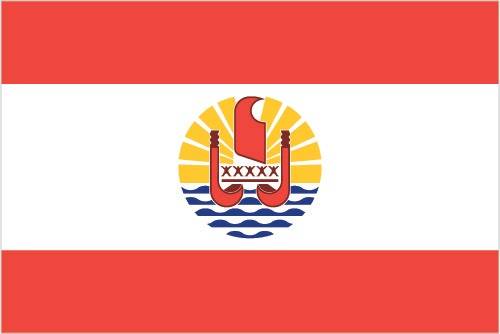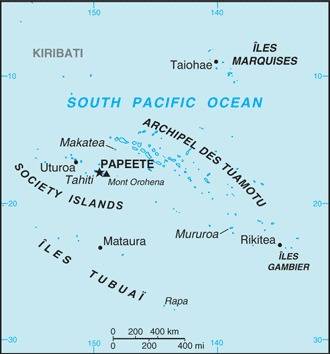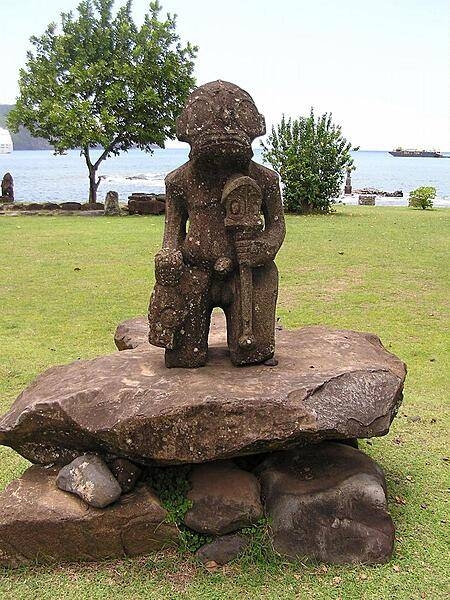70 French Polynesia (France)

Two red horizontal bands encase a wide white band in a 1:2:1 ratio. Centered on the white band is a disk with a blue and white wave pattern depicting the sea on the lower half and a gold and white ray pattern depicting the sun on the upper half. A Polynesian canoe rides on the wave pattern. The canoe has a crew of five represented by five stars that symbolize the five island groups. Red and white are traditional Polynesian colors.
Flag courtesy of the CIA World Factbook

Map courtesy of the CIA World Factbook

Stone tiki on Nuku Hiva Island in the Iles Marquesas archipelago.
Photo courtesy of the CIA World Factbook
Last updated on October 24, 2025
Government
According to Britannica, French Polynesia has greater autonomy than many other French possessions. Its legal status is that of an overseas country, which entails greater independence than that of an overseas department or territory. The constitution provides for a unicameral legislature, the French Polynesia Assembly, which is elected by universal adult suffrage and chooses the country’s president from among its members. The head of state is the French president, represented by a high commissioner appointed by the French government. The high commissioner is in charge of matters including defense, foreign relations, and justice. The head of government is the president of French Polynesia, who is assisted by a cabinet called the Council of Ministers. An Economic, Social and Cultural Council, made up of representatives from trade unions, various professional societies, and cultural and other organizations, serves as an advisory group to the government concerning proposed legislation. The country is represented in the French Parliament by two deputies and two senators. The judicial system includes a Court of Appeal, a Court of First Instance, and a Court of Administrative Law.
French Civil Aviation Authority (DGAC)
The DGAC, the French Civil Aviation Authority, is responsible for ensuring the safety and the security of French air transport, as well as maintaining a balance between the development of the air transport sector and environmental protection. It is the national regulatory authority, but it also provides safety oversight, air navigation services and training. He is a partner of key players in the aeronautical industry and he is also in charge of financial aid for research in aircraft construction and state industrial policy in this sector.
STATE CIVIL AVIATION SERVICE FRENCH POLYNESIA
Airspace
SkyVector – Google Maps – ADS-B Exchange
ICAO countries publish an Aeronautical Information Publication (AIP). This document is divided into three parts: General (GEN), En Route (ENR) and Aerodromes (AD). ENR 1.4 details the types of airspace classes they chose to adopt from classes A through G.
Drone Regulations
Advanced Air Mobility (AAM) Regulations & Policies
None found by the author.
However, should you, the reader, happen to stumble across something to the contrary, please email the author at FISHE5CA@erau.edu and you may be mentioned in the ACKNOWLEDGEMENTS section of this book by way of thanks for contributing to this free eBook!
Advanced Air Mobility (AAM) News
2025
Video courtesy of Advanced Air Mobility Institute from the July 2025 Global AAM Forum.
2025
Video courtesy of Advanced Air Mobility Institute from the January 2025 Global AAM Forum. Complete session for Day 1 of this Forum is available on the Advanced Air Mobility Institute YouTube Channel
Short Essay Questions
Scenario-Based Question
You have been hired by a Drone Startup Company. Your boss has immediately assigned this job to you.
They need you to prepare a one-page memo detailing the legalities of using a drone to film on Nuku Hiva Island, pictured above.
They need you to mention any national laws and local ordinances.
They specifically want to know what airspace (insert pictures) you will be operating in and whether or not you need an airspace authorization.
Does it matter whether or not you are a citizen of the country?
Lastly, there is a bonus for you if, as you scroll through this chapter, you find any typos or broken links!
Short Essay Questions
- What are the drone categories?
- How is registration addressed?
- How is remote ID addressed?
- What are the model aircraft rules?
- What are the commercial drone rules?
- Are there waivers or exemptions to the rules? If so, for what?
- Would you share a link to an interactive airspace map?
- How is BVLOS addressed?
- How can you fly drones at night?
- How can you fly drones over people?
- Where do you find drone NOTAMs?
- What are the rules for drone maintenance?
- What are the rules for an SMS program?
- What are some unique rules not mentioned above?
- What are the C-UAS rules?
- What are the AAM rules?

